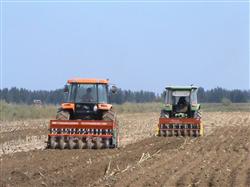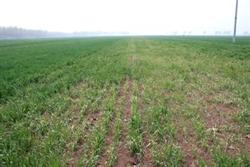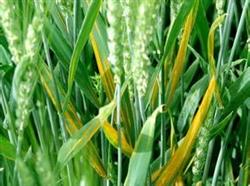Analysis of current Wheat Seedling situation and suggestions on Spring Management

After the beginning of winter in 2009, the climate was special, which seriously affected the growth and overwintering of winter wheat. In view of this situation, we conducted two wheat field visits before and after the Spring Festival, covering 30 counties (cities) in 8 regions of Hebei Province. now we analyze the results of the on-the-spot investigation and put forward management suggestions in spring. First, the situation of soil moisture is generally better. But poor land preparation of wheat fields, due to Xuan, straw, ventilation and leakage is serious, the return of pulp is not obvious, the dry soil layer is still 3-4 cm. With the rise of temperature, the re-sizing is not obvious. There will be a drought in this part of the wheat field. In the case of few secondary roots, the appearance of drought will obviously affect the growth. Second, compared with previous years, the situation of wheat seedlings in the province is generally poor this year, which is characterized by small population, weak individual and heavy freezing injury. There are three reasons: (1) climatic factors. In early November last year, during the peak period of wheat growth, the strong cold current came, greatly cooled down, suffered frost damage, and some wheat field leaves were frozen and withered. There was no good recovery of growth after frost. There was a sudden blizzard on November 10-13. Under the condition that there was basically no cold resistance exercise, insufficient nutrition accumulation and frost damage, it was covered for a long time. Photosynthesis is weak or basically no photosynthesis, but at this time the ground temperature is still high, wheat seedlings have slow growth and respiration under the snow, increasing their own consumption. On this basis, the snow thawed happened to encounter continuous strong low temperature weather, so it caused serious freezing damage to wheat seedlings this year. This is the key factor for the serious freezing injury of wheat this year. (2) extensive management. The investigation found that extensive cultivation aggravated the degree of freezing injury. The freezing injury in the wheat fields with poor soil preparation quality and shallow sowing is serious, and the seedling death rate is high. (3) the nature of the variety. Some varieties can not withstand the unusual weather changes that have not occurred in decades, showing obvious maladaptation, serious withering, and even dead seedlings. The specific performance of the seedling situation in the whole wheat field is as follows: 1. The group is small. The number of stems per mu of wheat fields in the province is basically less than 600000, mostly 400000 ~ 500000, 200000 ~ 300000 less than in previous years, or even more. two。 Individuals are weak. Because the growth period before winter in 2009 is more than 20 days, the accumulated temperature is less, and the wheat seedlings are mainly characterized by "two small and two less", that is, there are few tillers and few roots. The overall measurement of the province can be divided into two types, one is to overwinter with tillers, and the other is to overwinter with "bachelors". Most of the early sowing plants overwintered at the age of 3 leaves, 1 heart and 4 leaves, with 1 to 2 tillers, 2 to 3 tillers per plant, 1 to 3 secondary roots, generally less than 2 leaves, 2 tillers and more than 2 secondary roots than in previous years. In addition, a few wheat fields can reach 4 leaves and 1 heart (individual may have 4 leaves, 1 heart, 1 care) or 3 leaves, 1 heart, 1 care, 5 leaves overwintering, 2-3 tillers, 3-4 tillers per plant, 4 or so secondary roots. The proportion of this kind of wheat field is not large, and most of them are shallow sowing, often with heavy freezing injury, and belong to the second type of seedlings together with the above four-leaf wheat field, which is the main body of this year's wheat field. The wheat field sown later had only 2-3 leaf age, no tillering and no secondary rooting. There are also a small number of late-sowing wheat fields with crop rotation, a needle or even cover in the soil. Generally speaking, there are no or fewer first-class seedling fields. Coupled with the impact of freezing injury, strictly speaking, there are all three types of seedlings this year. 3. The freezing damage is serious. Due to climatic reasons, no matter the age of the seedlings, no matter which variety, the withered leaves overwintered, and the freezing injury was serious. It is only different in degree, which is mainly determined by the sowing quality of soil preparation, the cold current intensity between varieties and regions, and the snowfall intensity in November is different, some of which are still very different. (1) cultivation. The same variety, the same area, poor soil preparation, shallow sowing (too much straw in the surface layer, too much Xuan on the ground), the aboveground parts withered seriously, or all withered, there were dead seedlings, or even serious dead seedlings. (2) varieties. Under normal planting, the overwintering differences between varieties in the same region are shown every year, which is a normal phenomenon. But this year showed a big difference, basically for three types: ① with a certain green overwintering varieties, there is no seedling death phenomenon. There were almost no dead seedlings of ② varieties with withered leaves overwintering. ③ varieties with withered leaves overwintering and dead seedlings. These varieties are all varieties with severe frost injury in the severe cold current in early November, which is more prominent in some areas. (3) region. The degree of freezing injury among regions is consistent with the intensity of cold current, snowfall in November and the time of snow cover. The degree of freezing injury in Shijiazhuang is the most serious, basically withered leaves overwintering, there is the phenomenon of dead seedlings, some varieties seriously dead seedlings. Handan and Hengshui are the lightest, and most wheat seedlings in wheat fields overwinter with certain chloroplasts. Like Daming Wandi, many plots of Liuji Shimai 15 and Shijiazhuang 8 in Jingxian County are close to semi-green bodies to survive the winter. Xingtai, Cangzhou and Baoding are in the middle, with all the withered overwintering fields, most of which are overwintering fields with certain green bodies. Except for a few plots with cases, there are basically no dead seedlings. Although the aboveground part of wheat seedlings in the north (including Tianjin) was seriously withered, there were no dead seedlings at all. In other words, according to the overall measurement of the whole province, except Shijiazhuang, there is little problem of overwintering wheat seedlings in other wheat-producing cities. As far as Shijiazhuang is concerned, the serious death of seedlings is also in local areas and a few varieties. Therefore, it is very promising to strengthen spring management, promote the transformation and upgrading of seedlings, and strive for a bumper harvest. 3. Management suggestions: as the freezing injury of wheat this year is generally more serious than that of previous years, compared with other years, the period of returning to green will be postponed, especially in the wheat fields with heavy freezing damage, the leaves will all freeze to death, and it will take a long time to grow leaves from the growing point. therefore, the green period increases the difficulty of wheat management in spring. Therefore, the management should start as soon as possible this spring and strive for initiative. The main direction of wheat spring management should promote the early development and rapid growth of wheat seedlings, make effective use of spring tillers, increase the panicle rate and increase the number of grains per spike. The specific measures are as follows: (1) to suppress cuddling. All wheat fields should be suppressed and cuddled immediately so as to achieve the purpose of increasing soil moisture, preserving soil moisture, clearing ridges, increasing temperature and promoting early seedling development. (2) Scientific management of water and fertilizer. 1. For the wheat fields with poor soil preparation quality, shallow sowing, no watering before winter and no obvious soil regurgitation, the wheat fields should be watered immediately after the permafrost was cleared, and 15 kg / mu of available nitrogen fertilizer ammonium bicarbonate should be applied. two。 At present, the soil moisture of most wheat fields (main wheat fields) is better, do not rush to water and top dressing, in case the ground temperature drops and seedlings grow slowly after watering. However, proper early management is needed to comprehensively analyze the advantages and disadvantages. It is appropriate to water and fertilize this year (mid-and late-March in central and southern Hebei). The amount of water should not be too large. Depending on the application of nitrogen fertilizer, 10 kg of urea was applied per mu. If the base fertilizer is not applied potash fertilizer, about 10 kg potassium chloride is applied per mu, and nitrogen-potassium compound fertilizer is best used for topdressing. 3. For late sowing wheat, water and fertilizer management will be carried out after new tillers and new roots are grown. (3) to prevent cold in late spring. On the basis of severe overwintering frost damage to wheat, if it is cold in spring again, it can be said to be a fatal blow to wheat. Moreover, the temperature has fluctuated sharply since the Beginning of Spring, so measures must be taken to give priority to prevention, and must not be taken lightly and have a sense of luck. Irrigation is an effective measure to prevent cold in late spring. All kinds of wheat fields should properly arrange the order of rotation irrigation and complete one irrigation before jointing. (4) increase the application of foliar fertilizer to promote the transformation of seedling condition. As the seedling potential of wheat is weak and the ability of root system to absorb fertilizer is weak, attention should be paid to the application of foliar fertilizer to promote the transformation of seedling condition. About two spring leaves can be sprayed with 0.3% 0.5% potassium dihydrogen phosphate solution of 30 kg / mu, or other foliar fertilizers or growth regulators that have been proved to be effective by local practice, which can be sprayed continuously at intervals of 7-10 days. when carried out as far as possible combined with chemical weeding, pest control and other agricultural measures, strive to spray multi-effect, reduce manual input. (5) strengthen the prevention and control of diseases, insect pests and weeds. 1. Strengthen the monitoring and control of diseases such as sheath blight, root rot and powdery mildew. As the winter freezing injury of wheat is serious, it turns green late, the growth of wheat seedlings is weak, and the resistance to sheath blight, root rot and powdery mildew decreases, so it is necessary to pay close attention to the occurrence of the disease, strengthen monitoring and prevention, and spray fungicides. two。 Pay close attention to the occurrence and harm of wheat spiders. 3. Raise awareness and weed scientifically. Due to the weak wheat seedlings this year, the occurrence of weeds will be aggravated. Therefore, it is necessary to raise awareness and control weeds scientifically. As it snowed early last year, most wheat fields did not have time to implement "spring grass and autumn treatment", and the weeding effect of wheat fields sprayed with herbicides will also decline, so it is necessary to do a good job of chemical weeding in spring. However, due to the weak seedling potential of wheat this year, it is generally not suitable to spray herbicides to control Gramineae weeds in wheat fields with heavy freezing injury, so as to prevent drug damage. Broad-leaf weed herbicides should be selected. When the daily average temperature is higher than 10 ℃, tribenuron-methyl is used to control weeds. For example, 15 grams of 10% benzosulfuron per mu and 30 kg of water are sprayed evenly. The combination of weeding and pest control was carried out by spraying foliar fertilizer. The plots with heavy occurrence of Gramineae weeds should mainly be weeded and pulled out. (6) Scientific disaster reduction, except for low losses. For wheat fields with extremely serious dead seedlings, interplanting spring sowing crops such as cotton, peanuts, watermelons, vegetables, spring corn and oil sunflower can be changed according to the situation.
- Prev

Field Management techniques of Dryland Wheat in Spring
First, the cause of wheat seedling death in winter and spring 1. Internal cause refers to the ability of wheat plants to withstand cold and drought. Varieties with poor cold resistance are easy to cause dead seedlings. Individual sowing early, pre-winter ear differentiation to two-ridge stage of wheat seedlings, cold tolerance weakened, freezing injury often seriously killed seedlings, some late weak seedlings, their own accumulation.
- Next

The control of wheat diseases, insect pests and weeds in spring is the key.
If the disease center is found in the field, spray control should be carried out in time. If the rate of diseased leaves reaches 5% and the severity is less than 10%, use 15% vermicelli wettable powder 50 grams or 20% strychnine EC 40 milliliters per mu, or 25% vermicelli wettable powder 30 grams per mu, or 12.5% Supra wettable powder 15 grams per mu.
Related
- The first cup of black tea in spring, the flavor and history of tea gardens in Kenya, Africa
- The computer can not only choose potatoes, but also grow tea rice. AI will grow winter oolong tea champion.
- It is not only the inflated tea bitten by insects, but also engraved with the four seasons tea in Beipu.
- The Oriental Beauty Tea Festival in Zhuxian County takes the stage at the weekend to experience the plus-size feast of oil tea.
- & quot; Oriental Beauty Tea & Exploration of Emei in Hsinchu, the hometown of quot;
- The new variety of strawberry "Tainong 1" dessert is the first choice with mellow aroma. Crimson gorgeous
- History of Tea in Taiwan: from Wild Inner Mountain to Export Tea Garden
- Two types of Taiwan Oriental Beauty Black Tea won the British three-Star Award for Childhood Tea Xiang Zhang Jiaqi changed from pilot to champion tea maker.
- Banana species and varieties: the planting history of Taiwan Xianren banana and dwarf banana is long, is banana disease resistant?
- Coffee planting Technology: Qianjie Coffee from Seedling to harvesting

